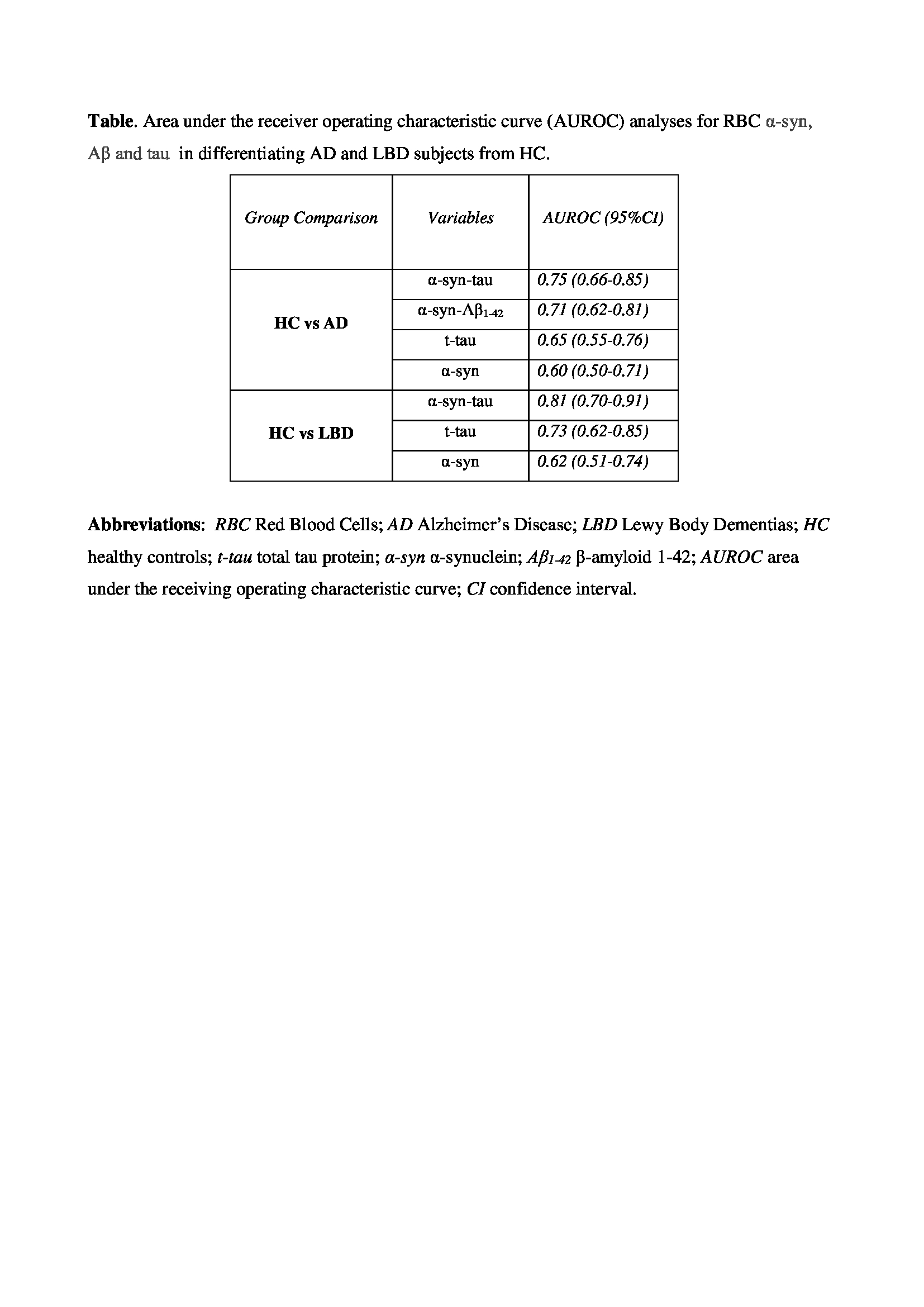Objective: To investigate the diagnostic value of red blood cells (RBC) levels of total alpha-synuclein (α-syn), beta-amyloid (Aβ) 1-42, tau and its heteroaggregates in Lewy body dementias (LBD), Alzheimer disease (AD) and healthy controls (HC).
Background: LBD are heterogeneous disorders in which AD related pathologies (tau and Aβ) are also a common feature thought to contribute to the cognitive decline. Similarly, ≥60% of AD cases have Lewy-type synucleinopathy pathology. α-syn, tau and Aβ have been shown to interact each other or with other “pathological proteins” to form toxic heteroaggregates. Red blood cells (RBC) account for more than 99% of a-syn concentrations in blood, representing an interesting in vivo model for studying pathophysiological mechanisms related to neurodegeneration.
Method: With a “homemade” sandwich enzyme-linked immunosorbent assay (ELISA) system, RBC levels of total α-syn, Aβ, tau and its heteroaggregates (α-syn/Aβ1-42 and α-syn/tau) were measured in 27 subjects with LBD (PDD, n=17; DLB, n=10), 51 subjects with AD (AD dementia, n=37, prodromal AD, n=14), and age-matched HC (n=60).
Results: Compared with HC, total tau and a-syn concentrations as well as α-syn/tau heterodimers were significantly lower in the AD group (p = 0.011, p = 0.003 and p < 0.001 respectively) and even further decreased in the LBD group (p = 0.009, p = 0.009 and p < 0.001 respectively) whereas the heteroaggregate a-syn/Aβ1-42 were only significantly lower in the AD dementia group (p<0.001). RBC α-syn/tau heterodimers had the higher diagnostic accuracy for differentiating patients with LBD vs controls (area under the receiver operating characteristic curve, 0.80). RBC total tau had a fair diagnostic accuracy (AUROC=0.73) in differentiating between the LBD group and controls whereas AUC values indicated only poor diagnostic accuracy for RBC total α-syn.
Conclusion: RBC α-syn heteroaggregates may be useful for differentiating between neurodegenerative dementias (LBD and AD) and HC. In particular, RBC α-syn/tau heterodimers has demonstrated good diagnostic accuracy for differentiating LBD from HC but are not consistently different between LBD and AD. Our findings also support the notion that α-syn, Aβ and tau interact in vivo to promote the aggregation and accumulation of each other presumably accelerating cognitive dysfunction.
To cite this abstract in AMA style:
G. Palermo, L. Giampietri, S. Daniele, R. Piccarducci, D. Frosini, G. Tognoni, U. Bonuccelli, C. Martini, F. Baldacci, R. Ceravolo. Red blood cells alpha-synuclein heteroaggregates in the differential diagnosis of Lewy body dementias, Alzheimer’s disease and healthy controls [abstract]. Mov Disord. 2020; 35 (suppl 1). https://www.mdsabstracts.org/abstract/red-blood-cells-alpha-synuclein-heteroaggregates-in-the-differential-diagnosis-of-lewy-body-dementias-alzheimers-disease-and-healthy-controls/. Accessed December 12, 2025.« Back to MDS Virtual Congress 2020
MDS Abstracts - https://www.mdsabstracts.org/abstract/red-blood-cells-alpha-synuclein-heteroaggregates-in-the-differential-diagnosis-of-lewy-body-dementias-alzheimers-disease-and-healthy-controls/

